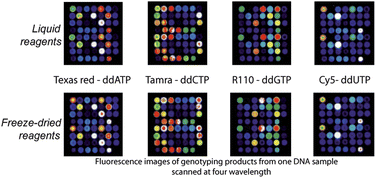Dried reagents for multiplex genotyping by tag-array minisequencing to be used in microfluidic devices†
Abstract
We present an optimized procedure for

* Corresponding authors
a
Department of Medical Sciences, Molecular Medicine, Uppsala University, University Hospital, Entrance70, Uppsala, Sweden
E-mail:
ann-christine.syvanen@medsci.uu.se
Fax: +46 18 553601
Tel: +46 18 6112959
b Department of Micro- and Nanotechnology, Technical University of Denmark, DTU Nanotech, Building 345 East, Kongens Lyngby, Denmark
c Department of Advanced Diagnostic Technologies, Division of Tumor Genetics, National Cancer Research Institute (IST-Genova), Largo Rosanna Benzi 10, Genova, Italy
We present an optimized procedure for

 Please wait while we load your content...
Something went wrong. Try again?
Please wait while we load your content...
Something went wrong. Try again?
A. Ahlford, B. Kjeldsen, J. Reimers, A. Lundmark, M. Romani, A. Wolff, A. Syvänen and M. Brivio, Analyst, 2010, 135, 2377 DOI: 10.1039/C0AN00321B
To request permission to reproduce material from this article, please go to the Copyright Clearance Center request page.
If you are an author contributing to an RSC publication, you do not need to request permission provided correct acknowledgement is given.
If you are the author of this article, you do not need to request permission to reproduce figures and diagrams provided correct acknowledgement is given. If you want to reproduce the whole article in a third-party publication (excluding your thesis/dissertation for which permission is not required) please go to the Copyright Clearance Center request page.
Read more about how to correctly acknowledge RSC content.
 Fetching data from CrossRef.
Fetching data from CrossRef.
This may take some time to load.
Loading related content
